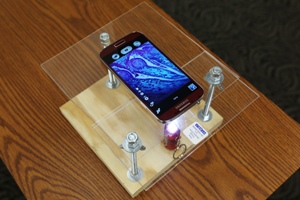Jul 30 2014
With nothing more than a smartphone and less than $10 of trinkets and hardware supplies, students at Missouri University of Science and Technology can build their own microscopes this fall as part of a biology lab.
 Daniel Miller, a recent biological sciences M.S. graduate from Missouri University of Science and Technology, built this do-it-yourself microscope with a smartphone and less than $10 in materials. Credit:Sam O'Keefe/Missouri S&T
Daniel Miller, a recent biological sciences M.S. graduate from Missouri University of Science and Technology, built this do-it-yourself microscope with a smartphone and less than $10 in materials. Credit:Sam O'Keefe/Missouri S&T
This do-it-yourself microscope is part of Missouri S&T’s effort to re-imagine how lab courses can be taught in five science and engineering disciplines on the campus. Organizers of the project hope to use the findings from their experiment to create a how-to manual for other colleges and universities.
The Transforming Instructional Labs project, which is funded through a grant from the University of Missouri System, also involves an evaluation of other universities that are experimenting with their instructional labs.
“We’re working with different lab courses on campus that use blended or online learning and plan to come up with an instructional model that could be reproduced anywhere,” says Angela Hammons, manager of instructional technology services at Missouri S&T.
This fall, students enrolled in two biological sciences courses taught by Terry Wilson, an associate teaching professor in that department, will be a part of this experiment. In one of those courses, General Biology, students will earn extra credit by building their own digital microscopes using carriage bolts, nuts, wing nuts, washers, plywood and Plexiglas from a hardware store, laser pointer lenses, LED click lights from a keychain flashlight to build a stand, and a smartphone for viewing and enlarging lab specimens. Rather than sending students on a sort of scavenger hunt for the parts, Wilson plans to make kits for the microscope stand available in the university’s bookstore.
The DIY microscopes can magnify samples up to 175 times with a single laser pointer lens, or nearly 400 times when stacking two lenses, says Daniel Miller, who recently earned his master of science degree in biological sciences from Missouri S&T. Miller created a prototype to use in Wilson’s General Biology lab last spring, where he served as a teaching assistant. He also offered extra credit to any of the 50 students in the lab who would build one. Fifteen students took him up on the offer.
“They love it,” says Miller. “They get to take it home and can use it to look at specimens whenever they want.”
That’s the plan for Wilson’s course. Students will be able to use the microscope at home. In addition, she will provide six of the microscope stands – one for each lab table in the room – for students to use during the instructional lab.
Wilson was looking at commercial kits and online versions of microscopes, but was not satisfied with what was available. When Miller showed her his prototype, “I was blown away by it,” she says. “I was really shocked by how good a job it does.”
In commercially available biology lab kits, “the microscope is usually the most expensive thing,” Wilson says. “This is much more cost-effective. It’s the perfect solution for us.”
Wilson also plans to experiment with her Cell Biology lab lecture this fall as part of the Transforming Instructional Labs project. She will be “flipping” the lab lecture part of the course by offering it online but will continue to offer the lab in the traditional manner. “This cuts face-to-face time down to two hours per week rather than three,” she says.
Flipped teaching or flipped classroom instruction is a form of blended learning, which combines online and in-person instruction. Flipped learning usually involves students and instructors working together in a classroom or lab to solve assigned problems – what used to be known as homework – rather than listening to lectures. In this scenario, students learn the course content outside of the classroom from online videos or other sources.
“What we’ve found is that while there is a lot of discussion about flipping the classroom in higher education, there aren’t many places doing much in terms of flipping instructional labs, especially in STEM (science, technology, engineering and math),” Hammons says.
Other courses involved in the Transforming Instructional Labs pilot program during the 2014-2015 academic year include the General Chemistry lab, the Introductory Physics lab, the Microbiology lab in biological sciences, the Mechanics and Materials laboratory in civil engineering and various labs in nuclear engineering. Instructors in these labs plan to develop learning kits to be used in the lab or outside of the classroom.
“We’ll be measuring the outcomes of these flipped labs and comparing them to traditional labs as part of this pilot project,” says Hammons.